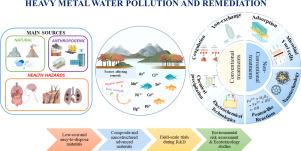Title: Shedding Light on Heavy Metal Contamination and Its Impact on Microbial Ecosystems in Guangxi’s Karst Regions
In the breathtaking karst landscapes of Guangxi, a hidden environmental crisis is emerging as heavy metal contamination increasingly infiltrates this distinctive ecosystem, jeopardizing the fragile equilibrium of its microbial populations. Isolated from major industrial hubs, these intricate limestone formations and their diverse biological life are now facing mounting ecological threats that pose serious risks to both local ecosystems and public health. Researchers are undertaking vital investigations into how pollutants such as lead, cadmium, and arsenic are permeating soil and water systems, fundamentally altering the essential components of life that lie beneath the surface. This article explores recent research findings regarding the effects of heavy metals on microbial communities in Guangxi’s karst region while emphasizing their implications for ecological stability and community livelihoods within one of China’s most stunning natural environments.
Tracing Pathways of Heavy Metal Pollution in Guangxi’s Karst Ecosystem
The complex karst topography of Guangxi is not exempt from the widespread issue of heavy metal pollution. Various human activities—most notably mining operations and industrial waste discharge—have introduced harmful metals like lead, cadmium, and mercury into local soil and water bodies. As these toxic substances undergo biogeochemical changes, they traverse through intricate hydrological systems within the region, significantly affecting local ecosystems. The pathways through which these contaminants travel include:
- Soil adsorption dynamics: Heavy metals can bind to soil particles; this allows them to be taken up by plants or leached into groundwater over time.
- Surface runoff mechanisms: Rainfall can wash contaminated surface waters into rivers or streams, propagating pollution downstream.
- Groundwater infiltration: Polluted waters seeping through karst aquifers may result in extensive underground contamination.
The resident microbial communities within these karst areas play an essential role in maintaining ecological balance by hosting various bacteria and fungi that facilitate mineral cycling as well as organic matter decomposition. However, exposure to heavy metal pollution severely disrupts these microbial ecosystems; it often leads to diminished biodiversity along with shifts in community structure. Studies indicate a direct relationship between levels of metal concentration and microbial viability—some species exhibit resilience while others decline sharply. Understanding these transformations is critical for evaluating ecological impacts concerning:
- Diversity composition: The presence of heavy metals may favor certain metal-resistant microorganisms over others.
- Microbial functionality: Changes in microbial functions could impede vital processes such as nutrient cycling.
- Potential for recovery: The ability for microbial communities to rebound from pollution largely depends on both concentration levels and types of heavy metals present.
Ecological Impact: Effects on Microbial Diversity & Community Health
The widespread challenge posed by heavy metal contamination within Guangxi’s karst regions is leading to significant disturbances among local microbial populations—a situation that ultimately threatens overall biodiversity. As toxic elements permeate soil and water systems, they modify physicochemical properties within habitats making them less hospitable for indigenous microbes.
Microorganisms serve as foundational components for ecosystem functionality; their decline could trigger cascading effects throughout complex ecological networks.
Key species like Geobacter, known for aiding bioremediation efforts alongside other beneficial microbes like Desulfovibrio, face heightened vulnerability due to such environmental changes impacting both aquatic habitats as well terrestrial ecosystems.
Evidently rising concentrations correlate with notable shifts observed among diverse microorganisms:
- A decrease in beneficial bacterial populations;
- An increase in pathogenic organisms;
- A shift towards metabolic pathways fostering resistance mechanisms against toxins;
The table below illustrates observed alterations regarding community structure linked with varying degrees of exposure to heavy metals:
| Toxic Metal Concentration (mg/kg) | Diversity Index Score | Main Microbial Phyla Present |
|---|---|---|
| No Exposure (0 – 10) | (3.8) | (Proteobacteria & Firmicutes) |
| (10 – 50) | < td >(2 .5 ) td >< td >(Bacteroidetes & Actinobacteria) td > tr >||
| Strategy Name th > | Description/Details Provided Here! th > tr > | |
|---|---|---|
| Community Education Workshops b> b> b>  ;  ;  ;  ;  ; </span></span></span></span>Educate locals identifying signs indicating possible contaminations best practices mitigating risks involved effectively! span >> | Research Collaborations b>>>< span class = "highlight" >>Form alliances universities/local governments driving scientific inquiries focused understanding regional ecosystems better comprehensively addressing challenges faced collectively! span >> | Financial Incentives Land Use Practices b>>< span class = "highlight" >>Providing monetary rewards landowners adopting eco-friendly techniques reducing runoff associated hazardous materials entering sensitive areas directly impacting surrounding wildlife habitats negatively over time! span >& gt;   ;   ; Conclusion: A Path Forward Towards Sustainability And Resilience For Future Generations Ahead!The ongoing investigation surrounding issues pertaining specifically relating back again towards detrimental impacts caused primarily due excessive amounts released during mining operations etc., highlights pressing concerns extending far beyond immediate consequences witnessed locally alone! As pollutants continue migrating throughout unique geological formations disrupting natural balances existing previously maintained amongst various forms life dependent upon them all interconnectedly intertwined intricately woven together harmoniously functioning symbiotically enhancing overall productivity experienced across entire landscape itself! Findings emphasize necessity implementing comprehensive approaches designed mitigate adverse effects protect biodiverse habitats crucial sustaining long-term viability future generations yet unborn who will inherit world left behind us today filled hope promise prosperity awaiting discovery just waiting patiently until we act decisively now before it becomes too late forevermore… Moving forward collaboration scientists/policymakers/community members alike remains paramount addressing lasting repercussions stemming directly resulting from ongoing crises brought forth due negligence shown historically past actions taken without foresight consideration consequences arising thereafter leading us down paths uncharted unknown territories fraught dangers lurking everywhere threatening existence itself if left unchecked indefinitely… |
